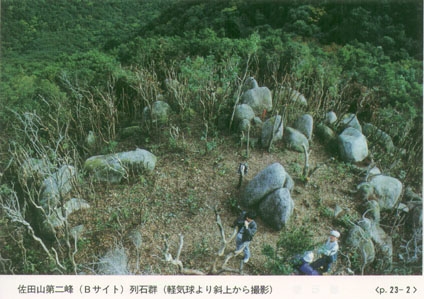
| 1. | The research and study over a period of approximately three years from fiscal 1993 to fiscal 1995 gave us many successful results that went far beyond our initial expectations. This paper briefly summarizes them. |
|---|
| (1) |
In fiscal 1993, we focused our research on the "mirror rock" type huge tones that spread out in the periphery of Cape of Ashizuri (centered on the coastline from Usubae to Ohiwa) and carried out experiments to measure the reflection degree of the "mirror rock" type huge stones in connection with the sun and the moon. The main measurement objectives were < 1 > the Tojin Stone (literally, the Chinese Stone) < 2 > the Sanretsu Seki (literally, the Three-row "mirror rock" at Dohgamori also written as Sanretsu Chu < literally, the Three-row Columns> located by the side of the Pacific Hotel) < 3 > the Ohiwa. |
|---|
|
The places where measurement were taken are < 1 > Tojin Daba, < 2 > Observatory, < 3 > swimming pool and roof of the Pacific Hotel and < 4 > at sea (on-boat observation and photographing). |
2. |
In fiscal 1994 the following three experiments and research were carried out : |
|---|
| (1) | An infrared ray experiment by Professor Yoshizo OKAMOTO, Assistant Professor Tatsuya NUMAO and Mr. Katashi KUROKAWA at Ibaraki University and a color inspection by Mr. Fumihiro NAKASHIGE, Mr. Shinobu KANATANI at Ricoh Co., Ltd. were performed in April and May. Important results were obtained for future research through the experiment and inspection, although effective results were not found. |
|---|---|
| (2) | The Sanretsu Seki and its surrounding stone circle
at Sadayama Site B (the 2nd summit of the Hakko mountains) were
photographed with a camera attached to a hot air balloon, which
was provided by Seiko Kan of Gunma Prefecture. As a result, we succeeded in taking pictures of the total arrangement (November). |
| (3) | It was clarified through petrographical research by Professor Hideo KAGAMI and Professor Daiko MICHISHIO at Josai University that two out of three stones of the Sanretsu Seki at the above-mentioned Sadayama Site B do not match the natural joint of rock, and that the two rocks were added later (after geological formation) by an artificial method (man power). Moreover, the circular stones surrounding them do not match the natural joint of rock at all (excepting two big stones) and were added later. |
It may be said that the stones falling
in the category of (II) such as those at the Sadayama Site B might
probaly be typical.
At present, the foregoing situation has
been clarified. The same may probably be true of the following
stones, which are widely distributed at the periphery of the Cape
of Ashizuri :
|
|
|
|
|
Stones called "Koyomi (calendar) Stone "(named by Mr. Bujio TOMITA) that were arranged to correspond to the seasonal movements of the sun and the moon. < P.24-5 > |
| (4) | The Tojin Stone, which occupies the central position of the huge stones at the periphery of Cape of Ashizuri. |
|
The Tojin Data, which is a plaza spreading in
front of the Tojin Stone. There is an extremely high possibility that the above-mentioned huge stones and arrangements should be regarded as structures having (A) natural stones and (B) artificial additions of stone. We cannot help thinking about this possibility. |
When were these artificial additions
made? To give an exact answer to this question, we have to wait
for archaeological excavations and surveys by archaeologists.
At present, however, we are permitted to make the following academic
suppositions :
| (a) | If the huge stones located here and there or densely over a vast area in the periphery of Cape of Ashizuri, which is 10 to 20 times as large as Korakuen stadium (at Suidobashi, Tokyo), are assumed to be artificial additions, then it should be considered that a large population existed,there. |
|---|---|
| (b) | Meanwhile, almost all those excavated (surface collection)
from plowed land in the locale (the periphery of Cape of Ashizuri
Tojin Daba, Matsuo, Usubae, etc. ) are Jomon ware and flint arrowheads
of the Jomon Period (obsidian produced at Himejima Island, Oita
Prefecture). The quantity of earthenware of the Yayoi Period and earthenware (Hajiki and Sueki) of the Period of Kofun (kofun = old burial mounds) and those of subsequent periods is much less. |
| (c) | Judging from this present situation, those who "executed" above-mentioned (II) were most probably people of the "Jomon Period". |
| (d) | The above-mentioned symbols of genital organs of "men and women" and forms of "big sea turtles" and the "arrangement of Koyomi (calendar) stones" can be understood most reasonably if they are assumed to belong to the Jomon Period. (If they were constructed after the Yayoi Period, the huge stones should have been developed into different forms like the formations of huge stones at Mr. Kohya (Shingon Religious Sect) formed in the medieval period and modern period.) |
| (e) | With respect to the circle stones at the above-mentioned Sadayama Site B, Mr. Taizo SAKAKI at Ricoh implies an interesting relation with constellations. His comment suggests "astronmical observations by the Jomon people" and will be one valuable datum for future research. |
| (1) | In fiscal 1995 two archaeologists visited the Cape of Ashizuri (Tosa Shimizu City) One was, Professor Shigetsugu SUGlYAMA at Kokugakuin University, a member of the Institute for Japanese Culture and Classics. The other was Dr. Meggers (Mrs. Evans at Smithsonian Institution, the U.S. A. ). Professor Sugiyama made a preliminary archaeological study of this, area (in August). It is expected that a good opportunity will come in the future, because this step will lead to full-scale research by him. |
|---|
| (2) | In August of 1995, the author (Furuta) encountered an important "theoretical discovery" during a visit to the cape with Professor Sugiyama. The "theoretical discovery" is titled in the appendix THE SELF-EVIDENT TRUTH OF THE JOMON STONES --Logic of Comparison between Japan and Britain-- |
|---|
| (3) | There is one thing to be mentioned : An inquiry into the
relationships with large areas peripheral to the area of Ashizuri
Cape is indispensable for the research. For example, comparison
with the relics such as Kami Kuroiwa (Ehime Prefecture) Kaseda
Kakoi ga hara (Kagoshima Prefecture). It is supposed that the
day will surely to come when research on the process of change
at the initial stage and the early stage of the Jomon period,
and moreover the Old stone Age, at the periphery of the Ashizuri
Cape will draw public attention and be spotlighted at the same
time. (This is triggered by the comment of Dr. Meggers.) The world might soon pay attention to and understand the geographical significance of this peripheral area of the Ashizuri Cape, which is the only point where the Asian Continent (and the Japan Archipelago as a part thereof) and the world's largest warm current (the Black Current) meet. The author hopes this report can make a contribution. |
|---|
| 4. | Finally, the author would like to point out that research and study over the past three years obtained successful results that had not been anticipated thanks to the best efforts and cooperation of the people concerned. |
|---|
With respect to the Sanretsu Seki of the relevant area, the author thinks as follows :
| (1) | The ancient people thought that " the Heavens,the land and the sea" are the three element which constitute the universe, and expressed each of these elements in the form of stone deity. This expression is by far the more objective and comprehensive than the inland Chinese expression of " the heavens and the land " |
|---|---|
| (2) | There in a distribution of festivals for the "
three-legged crow ( which possibly influenced ancient China.
The contents are described in detail in another paper ) "
mainly in the Kazusa and Shimofusa districts ( the northern part
of Chiba Prefecture and the southern part of lbaraki Prefecture,
And "three-fingered deity ( in the middle stage of Jomon
period )" at Idojiri ( Shinano Sakai, Nagano Prefecture
) is also famous from an archaeological viewpoint. What in more famous in a group of Yayoi Chieftain Burial Mounds ( at Yoshitake Takagi, Mikumo, Suku Okamoto, Iwara, Hirabaru, etc. ), located at the periphery of the Hakata Bay,Fukuoka,Kyushu. From these burial mounds of the Yayoi Period were excavated " Three Sacred Treasures ". We may be allowed to point out that there remains a possibility of ideological influence and conveyance from the preceding "Sanretsu Sekis" at the periphery of the Ashizuri Cape with these relics. The author would like to suggest that this point be an important topic of research in the future.<P.24-1. 2> |
< Supplement 2 >
With regard to a bird's-eye view image
(areal formation) of the huge stones (religious and festive remains)
in the relevant area, it was planned to take verifying photographs
from an artificial satellite, however the four-year plan was shortened
by one year , therefore, only part of the plan is expressed with
the photograph on the cover page.
< Supplement 3 >
The relevant area is an egg-laying place
for large sea turtles drifting in the Black Current. This is undoubtedly
the basis for the turtle-shaped huge stones. In connection with
the "sacred divination by turtle shells" (at Tsutsu,
Tsushima, Nagasaki Prefecture) on the Japan Archipelago, the "Reikiho"
in the Chou Era of China (a divination described in the Gishi
Wajin Den of Sangoku Shi), the author would like to suggest that
historical and folklore relationships with the areas (the southern
areas such as Micronesia, Polynesia and Melanesia in the Pacific
Ocean) from which the sea turtles start their journey will be
a central theme of research in the future.
< Supplement 4 >
It will be necessary to research into
the Old Stone Age on the periphery of this area in future.
General editor : Takehiko Furuta (professor of Showa Pharmaceutical
College)


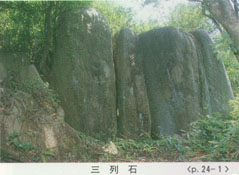
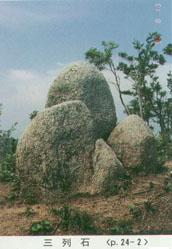
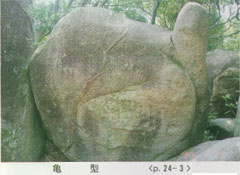

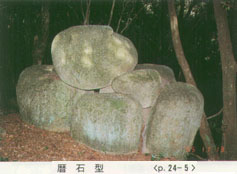
The Giant Stones Around Ashizuri Cap
Back to Home Page
for THE SELF-EVIDENT TRUTH
OF THE JOMON STONES
Created by "Yukio Yokota"
Copyrighted by "Tosashimizu City Board of Education"